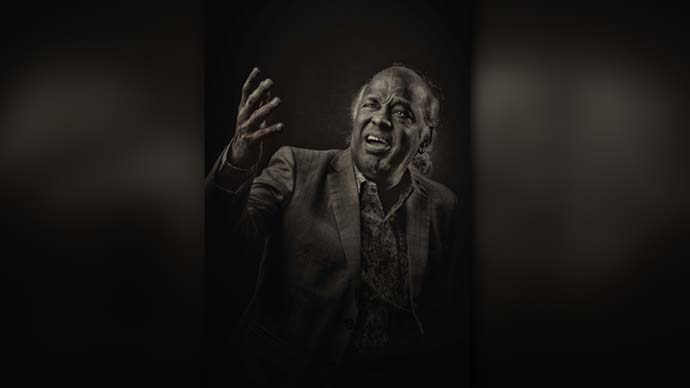Remembering Rahat Indori: A fiery solace

Despite often being scoffed at by the purists, Rahat Indori’s evocative and easily graspable poetry, richly expressive of life and our common social concerns, makes him the poet of the masses. The poet passed away on August 11, 2020.
My introduction to Rahat Indori had the background score of thunderous applause - just as his name was announced at the Mushaira. A dark bald man – looking more like a retired PSU employee than a poet – slowly walked to the centre of the stage. As his recitation unfurled – a street-drawl tone laced with mischievous wincing of one eye, smirks, and sarcastic laugher – it was like an impassioned personal conversation with humanity.
Zooming on him with my long lens, I saw his eyes were not on the audience, they hovered above towards the roof of the pandal as if he was addressing a common spirit rising from the collective. His eyes rolling towards the sky, the hands animatedly rendering in space the contours of his imagination. As this rousing recitation progressed, his aura loomed over the entire gathering. He was soon like a Moses of Urdu, raising the oceanic applause to the command of his verse.
चमकते लफ़्ज़ सितारों से छीन लाए हैं
हम आसमान से ग़ज़ल की ज़मीन लाए हैं
Chamakte lafz sitāroñ se chhīn laa.e haiñ
ham āsmāñ se ġhazal kī zamīn laa.e haiñ

Known and feted for his dramatic recitation, Rahat Sahib, along with poets like Munnawar Rana, popularised and brought back the dramatic `tahat’ or the spoken oration of Urdu ghazal which by the 1970s was largely read in `tarannum’ or the singing recitation. It was an age of being angry and tarannum recitation seemed to bind and soften the edge of defiant thought. And for Rahat Indori, this defiance was the very credo of his poetry. If not for his powerful and sometimes risqué love poetry — which tempers his revolutionary fervour — Rahat would easily make a Che Guevara of contemporary Urdu verse.
राज़ जो कुछ हो इशारों में बता भी देना
हाथ जब उस से मिलाना तो दबा भी देना
Raaz jo kuch ho ishaaron me bataa bhi dena
Haath jab us se milana to dabaa bhi dena
His most quoted verses are the ones that are scathingly contemptuous of the political establishment and extremely critical of the current attempts at cultural homogenisation. His iconic ghazal, Agar Khilaaf Hain, appears as if a startling articulation of the recent anti-NRC protest sentiments.
जो आज साहिब-ए-मसनद हैं, कल नहीं होंगे
किरायेदार हैं ज़ाती मकान थोड़े है
सभी का खून शामिल है यहाँ की मिट्टी में
किसी के बाप का हिन्दोस्तान थोड़े है
Jo aaj saahib-e-masnad hain kal nahin honge
Kiraaydaar hain zaati makaan thodi hai;
Sabhi ka khoon shaamil yahan ki mitti me
Kisi ke baap ka hindustan thodi hai
This last sher is the nearest possible expression of an expletive in Urdu ghazal. It vocalises the poet’s explosive anger towards forces that threaten India’s composite culture. No wonder, this couplet was seen all over on posters at Shaheen Bagh.
Rahat Sahib’s poems draw parallels with the verses of two other fiery poets of the 1970s — Dushyant Kumar and Faiz Ahmed Faiz. Strongly anti-establishment, his poetry is not an articulation of an intricate exploration of the self but is an intense expression of his social engagement with life and its contemporary political concerns. The tone of his ghazal is more exhortatory than revelatory.
सब के दुःख सुख उस के चेहरे पर लिखे पाए गए
आदमी क्या था हमारे शहर का अख़बार था
Sab ke dukh sukh us ke chehre par likhe paa.e ga.e
Aadmī kyā thā hamāre shahr kā aḳhbār thā
Despite his frequent addressing of the crises of Islamic faith in India, Rahat’s poetry is steeped in our composite culture. His disruptive use of Hindu cultural symbols in his Urdu is to assert his Hindustani identity.
नमाज़ें मुस्ताक़िल पहचान बन जाती है चेहरों की
तिलक जिस तरह माथे पर कोई हिंदू लगाता है
अंधेरे और उजाले में ये समझौता ज़रूरी है
निशाने हम लगाते हैं ठिकाने तू लगाता है
namāzeñ mustaquil pahchān ban jaatī hai chehroñ kī
tilak jis tarah māthe par koī hindū lagātā hai
añdhere aur ujāle meñ ye samjhauta zarūrī hai
nishāne ham lagāte haiñ Thikāne tū lagātā hai
A distinct feature of Rahat’s writings is his use of Urdu spoken in the lanes and by-lanes of Indian towns — complete with its slangs and twangs — just as the use of the word ‘thikaane’ above. This is best illustrated by this ghazal which employs the street slang ‘jaane ka nai’ even using the sound of ‘nai’ instead of ‘nahin’.
बुलाती है मगर जाने का नई
वो दुनिया है उधर जाने का नई
सितारे नोच कर ले जाऊँगा
मैं ख़ाली हाथ घर जाने का नई
Bulātī hai magar jaane kā na.iiñ
vo duniyā hai udhar jaane kā na.iiñ
sitāre noch kar le jā.ūñgā
maun ḳhālī haath ghar jaane kā na.iiñ

Despite often being scoffed at by the purists, Rahat Indori’s evocative and easily graspable poetry, richly expressive of life and our common social concerns, make him the poet of the masses. His poetry can be identified by even looking at a silent video clip of the Mushaira audience. People clapping animatedly would mean a poet like Gulzar Sahib or Javed Akhtar is on stage, audience ecstatically throwing up their arms in the air would mean someone like Waseem Bareilavi or Gopal Das Neeraj is reciting, but when you see the gathering — especially young men — leaping from their seats in frenzy like football fans, their eyes dilated in rapture and baring their teeth as they shout, know that Rahat Indori just read his ghazal.

